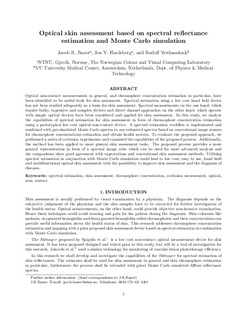| dc.contributor.author | Bauer, Jacob Renzo | |
| dc.contributor.author | Hardeberg, Jon Yngve | |
| dc.contributor.author | Verdaasdonk, Rudolf | |
| dc.date.accessioned | 2017-11-14T08:06:53Z | |
| dc.date.available | 2017-11-14T08:06:53Z | |
| dc.date.created | 2017-04-28T14:28:41Z | |
| dc.date.issued | 2017 | |
| dc.identifier.citation | Proceedings of SPIE, the International Society for Optical Engineering. 2017, 10057 . | nb_NO |
| dc.identifier.issn | 0277-786X | |
| dc.identifier.uri | http://hdl.handle.net/11250/2466039 | |
| dc.description.abstract | Optical non-contact measurements in general, and chromophore concentration estimation in particular, have been identified to be useful tools for skin assessment. Spectral estimation using a low cost hand held device has not been studied adequately as a basis for skin assessment. Spectral measurements on the one hand, which require bulky, expensive and complex devices and direct channel approaches on the other hand, which operate with simple optical devices have been considered and applied for skin assessment. In this study, we analyse the capabilities of spectral estimation for skin assessment in form of chromophore concentration estimation using a prototypical low cost optical non-contact device. A spectral estimation work flow is implemented and combined with pre-simulated Monte Carlo spectra to use estimated spectra based on conventional image sensors for chromophore concentrations estimation and obtain health metrics. To evaluate the proposed approach, we performed a series of occlusion experiments and examined the capabilities of the proposed process. Additionally, the method has been applied to more general skin assessment tasks. The proposed process provides a more general representation in form of a spectral image cube which can be used for more advanced analysis and the comparisons show good agreement with expectations and conventional skin assessment methods. Utilising spectral estimation in conjunction with Monte Carlo simulation could lead to low cost, easy to use, hand held and multifunctional optical skin assessment with the possibility to improve skin assessment and the diagnosis of diseases. | nb_NO |
| dc.language.iso | eng | nb_NO |
| dc.publisher | Society of Photo-optical Instrumentation Engineers (SPIE) | nb_NO |
| dc.title | Optical skin assessment based on spectral reflectance estimation and Monte Carlo simulation | nb_NO |
| dc.type | Journal article | nb_NO |
| dc.type | Peer reviewed | nb_NO |
| dc.description.version | submittedVersion | nb_NO |
| dc.source.pagenumber | 9 | nb_NO |
| dc.source.volume | 10057 | nb_NO |
| dc.source.journal | Proceedings of SPIE, the International Society for Optical Engineering | nb_NO |
| dc.identifier.doi | 10.1117/12.2252097 | |
| dc.identifier.cristin | 1467258 | |
| dc.relation.project | Norges forskningsråd: 247689 IQ-MED | nb_NO |
| dc.description.localcode | This is the authors' manuscript to the article. Copyright 2017 Society of Photo Optical Instrumentation Engineers (SPIE). One print or electronic copy may be made for personal use only. Systematic reproduction and distribution, duplication of any material in this publication for a fee or for commercial purposes, or modification of the contents of the publication are prohibited. | nb_NO |
| cristin.unitcode | 194,18,21,70 | |
| cristin.unitname | Norwegian Media Technology Lab | |
| cristin.ispublished | true | |
| cristin.fulltext | preprint | |
| cristin.qualitycode | 1 | |
